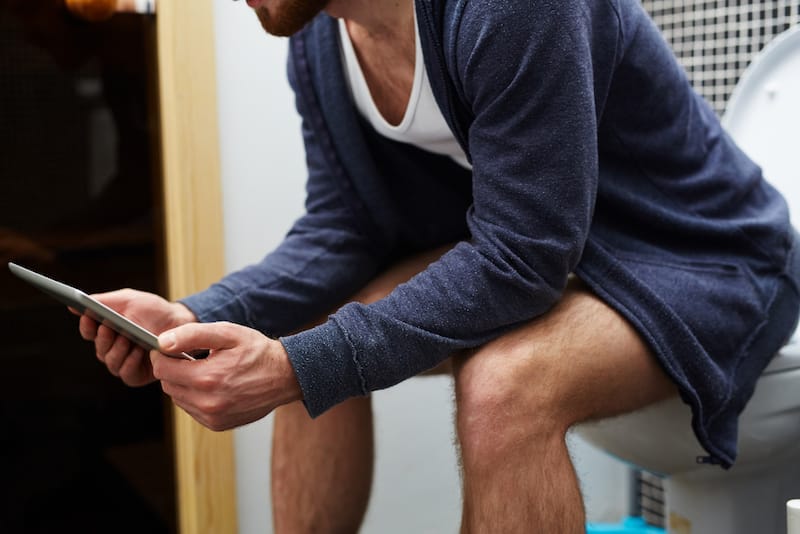Root-like sticks in our stool can result from our fibrous food intake and medical conditions that cause indigestion. Other conditions affecting our stools’ appearance include irritable bowel syndrome, celiac disease, and Crohn’s disease. In addition, common symptoms like nausea and abdominal pain make it difficult to self-diagnose and would need medical consultation. On the other hand, different types of stools, like hard stools and loose stools, can be dealt with by home remedies themselves. Generally, you can ensure healthy stools by engaging in a healthy lifestyle, like daily exercise, staying hydrated, and avoiding highly processed foods.
There is no such thing as an ideal poop. Different poop types, shapes, and colors can come out of us as they’re simply a reflection of what we eat and what goes on in our bodies.
From hard little pellet-type stools to watery diarrhea can be classified into the categories listed in the Bristol stool scale.
Various colored patches and root-like sticks in your stool indicate what your body has digested.
It’s easy to even mistake these root-like substances with other possibilities, possibilities that will be handled in today’s read.
Why does your stool look like it has root-like sticks in it? What is a fiber string in a stool? What are the common symptoms of a bowel disorder?
What are the types of stools, and what does it mean? How can you ensure healthy stool?
Why does your stool look like it has root-like sticks in it?
Don’t worry! Root-stick-like things in your stool have a reasonable explanation for it.
The following list includes the most likely explanations for your predicament.
- Undigested food – Eating fibrous food can give your stool a root-stick-like appearance. This isn’t something to be so concerned about unless you’re experiencing other physical discomforts like dizziness, nausea, or fever.
- Intestinal worms – You might mistake various intestinal parasites and worms as root sticks as they take a similar shape at first glance. Hookworms, flukes, and pinworms are just a few examples. A 2015 study conducted shows that, on an estimate, more than one billion people in the world are diagnosed with intestinal pinworms.
- Medical conditions – Various complications in your body can lead to indigestion, making your stool difficult to identify. If you’re facing other symptoms like bloody stools, nausea, and fever, you might face digestive complications like irritable bowel syndrome, intestinal infections, and colorectal cancers.
What is a fiber string in a stool?
Eating fibrous foods is a popular treatment for constipation. But to cure constipation, you’re going to need a little more than that.

Fiber, as well as drinking lots of water, plays a huge role because hydration helps best to pass stool with minimum discomfort.
Fiber works by absorbing water in your body, so if you’re not drinking proper amounts of water, it can lead you to give out stool with tiny strings attached at the ends of your stool.
This will look like a root stick-like thing known as a fiber string and cause a lot of strain in your next bowel movement.
If you’re suffering from constipation, the best fix would be to drink plenty of fluids, change your diet into a healthy one with a lot of probiotics in it, and you can also try adding peppermint essential oil.
In a 2019 study conducted by the US National Library of Medicine, it was proved that peppermint oil was a safe and effective therapy for adults with irritable bowel syndrome or constipation.
What are the common symptoms of bowel disorders?
If your worries are only related to the physical appearance of your stool having a root stick-like thing, chances are that your stool is still healthy.
But if you’re facing other symptoms as well, you’re right to wonder what could be wrong with your body.
The list below will help you identify potential red flags regarding digestive health.
- Abdominal pain – A common symptom of medical conditions such as irritable bowel syndrome, food allergies, food poisoning, lactose intolerance, and even stomach viruses.
- Gas and bloating – Excess gas can be caused by diseases like constipation, celiac disease, Crohn’s disease, and colon cancer in rare instances. This symptom can be seen when your body struggles more with digestion.
- Nausea – Nausea and vomiting are common symptoms of bowel disorders and can be mainly seen in instances of food poisoning, appendicitis, and blocked intestine.
- Constipation – While constipation itself can be a disease, it’s also a symptom of various digestive disorders like complications in your endocrine, diverticular disease, and colorectal cancer.
- Diarrhea – Many viruses can cause diarrhea, including the Norwalk virus, Astrovirus, and viral hepatitis. Digestive disorders like Crohn’s disease too often give out symptoms of diarrhea.
Types of stools and what it means

Apart from root stick-like things in stool, many forms and textures of stool can indicate what we eat and what our body lacks.
The following chart will help you reassess your diet and understand what your stool means.
| Types of stools | What it means |
|---|---|
| Loose stools | These stools are often caused by stress and intestinal infections and can be triggered by medications that have diarrhea as a side effect. |
| Hard stools | This common effect of constipation is often triggered by a lack of water intake and dietary fiber. In addition, if you hold your stool in for long periods, hard stools may happen. |
| Different colored stools | Various naturally and artificially colored foods can cause your stool to be of a similar color. If you experience green, pale, or black-colored stool, you’ll need to consult your doctor. |
| Mucus covered stools | Having small amounts of mucus appear on your stool is quite normal. But if you notice larger amounts, it may indicate an infection or diseases like celiac disease, Crohn’s disease, and ulcerative colitis. |
| Bloody stools | This is a little more serious and needs to be communicated to your doctor. It can result from an anal fissure or bleeding hemorrhoid, and on certain occasions, it can be a cancer symptom. |
| Floating stools | The occasional floating stool is harmless and can indicate intestinal gas or a recent diet change. However, if it’s frequent and accompanied by a foul smell and oily form, it can be a symptom of a more severe health problem called steatorrhea. |
How do you ensure healthy stool?
The appearance of your stool is not a pressing concern as long as it isn’t uncomfortable.

If you want a healthier and easier bowel movement, you can follow certain home remedies to boost the passing of your stool.
- Fiber and hydration – These two aspects go hand in hand. If you only look into your fiber intake and ignore your water intake, you’ll expect more root stick-like things in your stool. So make sure you drink at least 8-10 glasses of water daily along with a fibrous diet, including berries, beans, avocados, whole grains, and dried fruits.
- Cut out stomach irritating foods – This is essential in preventing conditions like irritable bowel syndrome or constipation. If you don’t want to see your undigested food coming out of your stool, you might have to minimize your fatty food intake, caffeinated drinks, and spicy foods, and stay away from highly processed foods.
- Be physically active – If your body isn’t doing its task of moving stool forward in your digestive tract, then you can help it out by engaging in regular exercises. You don’t have to go all out. You can simply engage in daily walks, runs, jogging, and swims to promote motion in your body to help poop better.
- Include fruits, nuts, grains, and vegetables in your diet – These types of foods are healthy and agreeable to your body. It adds bulk to your stool and helps stimulate your bowels to properly push your stool forward, as proven by various studies. Try including apples, strawberries, sunflower seeds, almonds, carrots, and whole-grain bread in your diet, and watch the magic happen.
Conclusion
A healthy gut not only ensures your body’s well-being but also affects your mental status.
Although conditions like constipation and diarrhea are not that serious, still the discomfort faced in passing our stool would put us in a foul mood.
Since you can easily peek a glance at the state of your poop, it’s an easy method of self-diagnosing a possible illness. By observing, you can also modify your diet in a way that could help your bowel movements.
So, make sure you know what leaves your body for you to understand the cause of your stool form and be cautious in cases you might need medical assistance.
There’s no shame in wanting to maintain a healthy digestive system!


